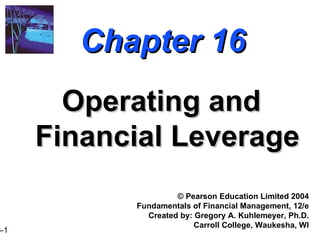0273685988 Ch16
•Descargar como PPT, PDF•
3 recomendaciones•1,128 vistas
Denunciar
Compartir
Denunciar
Compartir

Recomendados
Recomendados
Fundamentals of ABM2
based on the book Fundamentals of ABM 2 by D. R. C. Salazar, CPA
Learning Competencies Covered:
ABM_FABM12-Ic-d5
ABM_FABM12-Ic-d6
ABM_FABM12-Ic-d7Fundamentals of abm2 statement of comprehensive income abm specialized subject

Fundamentals of abm2 statement of comprehensive income abm specialized subjectGian Paulo Rabanal, LPT
Más contenido relacionado
La actualidad más candente
Fundamentals of ABM2
based on the book Fundamentals of ABM 2 by D. R. C. Salazar, CPA
Learning Competencies Covered:
ABM_FABM12-Ic-d5
ABM_FABM12-Ic-d6
ABM_FABM12-Ic-d7Fundamentals of abm2 statement of comprehensive income abm specialized subject

Fundamentals of abm2 statement of comprehensive income abm specialized subjectGian Paulo Rabanal, LPT
La actualidad más candente (20)
Pembentukan persekutuan AKUNTANSI KEUANGAN LANJUT 1

Pembentukan persekutuan AKUNTANSI KEUANGAN LANJUT 1
Consolidated Financial Statements and Outside Ownership

Consolidated Financial Statements and Outside Ownership
akuntansi keuangan lanjutan 2 "Organisasi Nirlaba" 

akuntansi keuangan lanjutan 2 "Organisasi Nirlaba"
Akuntansi Manajemen Edisi 8 oleh Hansen & Mowen Bab 6

Akuntansi Manajemen Edisi 8 oleh Hansen & Mowen Bab 6
Fundamentals of abm2 statement of comprehensive income abm specialized subject

Fundamentals of abm2 statement of comprehensive income abm specialized subject
Destacado
Destacado (14)
jimmy stepanian | Capital structure | Financial Structure | decisions | 

jimmy stepanian | Capital structure | Financial Structure | decisions |
Operating Leverage - Finacial leverage & Break-Even

Operating Leverage - Finacial leverage & Break-Even
Similar a 0273685988 Ch16
Similar a 0273685988 Ch16 (20)
FINANCAL MANAGEMENT PPT BY FINMANLeverage and capital structure by bosogon an...

FINANCAL MANAGEMENT PPT BY FINMANLeverage and capital structure by bosogon an...
Más de kpserver
Último
Último (20)
What is paper chromatography, principal, procedure,types, diagram, advantages...

What is paper chromatography, principal, procedure,types, diagram, advantages...
Toyota Kata Coaching for Agile Teams & Transformations

Toyota Kata Coaching for Agile Teams & Transformations
Guide to Networking Essentials 8th Edition by Greg Tomsho solution manual.doc

Guide to Networking Essentials 8th Edition by Greg Tomsho solution manual.doc
Powers and Functions of CPCB - The Water Act 1974.pdf

Powers and Functions of CPCB - The Water Act 1974.pdf
HAL Financial Performance Analysis and Future Prospects

HAL Financial Performance Analysis and Future Prospects
Sedex Members Ethical Trade Audit (SMETA) Measurement Criteria

Sedex Members Ethical Trade Audit (SMETA) Measurement Criteria
0273685988 Ch16
- 1. Chapter 16 Operating and Financial Leverage © Pearson Education Limited 2004 Fundamentals of Financial Management, 12/e Created by: Gregory A. Kuhlemeyer, Ph.D. Carroll College, Waukesha, WI
- 23. Interpretation of the DOL 2,000 4,000 6,000 8,000 1 2 3 4 5 QUANTITY PRODUCED AND SOLD 0 -1 -2 -3 -4 -5 DEGREE OF OPERATING LEVERAGE (DOL) Q BE
- 29. Application of DOL for Our Three-Firm Example The ranked results indicate that the firm most sensitive to the presence of operating leverage is Firm F . Firm F DOL = 8.0 Firm V DOL = 6.6 Firm 2F DOL = 2.0 Firm F will expect a 400% increase in profit from a 50% increase in sales (see Slide 16-7 results).
- 34. EBIT-EPS Chart 0 100 200 300 400 500 600 700 EBIT ($ thousands) Earnings per Share ($) 0 1 2 3 4 5 6 Common
- 36. EBIT-EPS Chart 0 100 200 300 400 500 600 700 EBIT ($ thousands) Earnings per Share ($) 0 1 2 3 4 5 6 Common Debt Indifference point between debt and common stock financing
- 38. EBIT-EPS Chart 0 100 200 300 400 500 600 700 EBIT ($ thousands) Earnings per Share ($) 0 1 2 3 4 5 6 Common Debt Indifference point between preferred stock and common stock financing Preferred
- 39. What About Risk? 0 100 200 300 400 500 600 700 EBIT ($ thousands) Earnings per Share ($) 0 1 2 3 4 5 6 Common Debt Lower risk . Only a small probability that EPS will be less if the debt alternative is chosen. Probability of Occurrence (for the probability distribution)
- 40. What About Risk? 0 100 200 300 400 500 600 700 EBIT ($ thousands) Earnings per Share ($) 0 1 2 3 4 5 6 Common Debt Higher risk . A much larger probability that EPS will be less if the debt alternative is chosen. Probability of Occurrence (for the probability distribution)
- 54. Risk versus Return Compare the expected EPS to the DTL for the common stock equity financing approach to the debt financing approach. Financing E(EPS) DTL Equity $3.50 1.20 Debt $5.60 1.50 Greater expected return (higher EPS) comes at the expense of greater potential risk (higher DTL)!
- 59. Coverage Example Compare the interest coverage and debt burden ratios for equity and debt financing. Interest Debt-service Financing Coverage Coverage Equity Infinite Infinite Debt 5.00 2.50 The firm actually has greater risk than the interest coverage ratio initially suggests.
- 60. Coverage Example -250 0 250 500 750 1,000 1,250 EBIT ($ thousands) Firm B has a much smaller probability of failing to meet its obligations than Firm A. Firm B Firm A Debt-service burden = $200,000 PROBABILITY OF OCCURRENCE